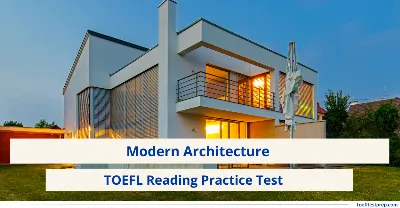Modern Architecture - TOEFL iBT® Reading Practice Test

"Enhance your TOEFL Reading skills with this practice test on 'Modern Architecture.' Strengthen your comprehension to succeed in the TOEFL exam."
Key Highlights
In the TOEFL Reading section, you'll read academic passages on topics like 'Modern Architecture.' This task evaluates your ability to understand detailed information, analyze structure, and connect ideas presented in a text.
Engaging with passages about 'Modern Architecture' will improve your academic reading skills, helping you approach complex topics with confidence in the TOEFL test.
Reading Instructions:
- You have 15 minutes to read the following passage and answer all 9 questions related to it.
- Most questions are worth 1 point, but the last question is worth more. The directions indicate how many points you will receive for that specific question.
- The specific section/paragraphs have been provided again with the question for ease of understanding and quick solution.
- Some questions include a word or phrase that is highlighted in the question as well as in the paragraph for quick reference.
Modern Architecture
Modern architecture refers to a wide range of styles and movements that appeared in the late 19th and early 20th centuries as a response to rapid industrialization and urban growth. This building shift marked a break from traditional forms and embraced new materials and technologies. The introduction of steel and strengthened concrete allowed architects to design taller and more flexible structures. Additionally, the use of glass as a main building material led to bright, open spaces that changed how we experience the inside and outside of buildings. Historical records show that this change was not just about beauty; it reflected larger societal shifts, including the growth of modern cities and the need for useful public spaces.
One of the most important movements in modern architecture is the International Style, which became popular in the 1920s and 1930s. This style focuses on minimalism, usefulness, and a lack of decoration. Architects like Le Corbusier and Ludwig Mies van der Rohe promoted the idea that form should follow function, resulting in buildings that prioritized practicality over ornamentation. Features like flat roofs, open floor plans, and large windows became characteristics of this style, reflecting a new look that aimed to blend with the modern industrial landscape. The Bauhaus school in Germany played an important role in spreading these ideas, encouraging a mix of art, craft, and technology. Studies suggest that the Bauhaus's influence reached beyond Europe, shaping modernist movements around the world.
But modern architecture faced criticism. Some argued that the stark, functional designs of the International Style lacked warmth and character. Critics claimed that focusing too much on utility often led to lifeless spaces that didn't connect with people. For example, architects like Frank Lloyd Wright, who supported organic architecture, offered a different view. Wright's designs, such as the famous Fallingwater, aimed to blend buildings with their natural surroundings, promoting a sense of place and connection to nature. This tension between modernist ideals and the desire for a more human-centered approach still influences architectural discussions today, raising questions about the role of beauty in modern design.
The period after World War II saw further changes in modern architecture, as architects began to explore new materials and technologies. The rise of prefabrication and modular construction made building faster, which was especially useful for post-war reconstruction. Architects like Richard Rogers and Renzo Piano embraced these innovations, as seen in their design of the Centre Pompidou in Paris. This building, with its exposed structural elements and bright colors, challenged traditional ideas about architectural beauty and function. The Centre Pompidou became a symbol of the high-tech architecture movement, celebrating the visibility of mechanical systems and the use of industrial materials. This shift transformed not only architectural practices but also urban planning and how public spaces are used.
In recent years, sustainable architecture has added another layer of intricacy to modern architectural practices. As concerns about climate change and resource reduction have grown, architects have increasingly aimed to create buildings that reduce environmental impact. This has led to the use of green technologies, such as solar panels, rainwater harvesting systems, and energy-efficient materials. Notable examples include the Bosco Verticale in Milan, which features vertical gardens that improve air quality and lower energy use. This move toward sustainability reflects a growing awareness of how architecture and the environment are connected, prompting architects to think about the long-term effects of their designs. However, debates continue about finding the right balance between beauty and environmental responsibility, highlighting the ongoing challenges faced by modern architects.
In conclusion, modern architecture represents a changing field that reflects broader societal shifts and technological progress. From the minimalist principles of the International Style to the combining of sustainable practices, the field continues to adapt to today's challenges. The ongoing conversation between tradition and innovation, functionality and beauty, will shape the architectural landscape for years to come. As architects deal with issues like urban density, climate change, and social equity, the future of modern architecture remains uncertain but hopeful. This varied exploration invites further questions into how architectural practices can help create a more sustainable and fair built environment, ultimately influencing modern society and urban planning.
Directions: Once you have read the passage, answer the following questions.
Paragraph 1
Modern architecture refers to a wide range of styles and movements that appeared in the late 19th and early 20th centuries as a response to rapid industrialization and urban growth. This building shift marked a break from traditional forms and embraced new materials and technologies. The introduction of steel and strengthened concrete allowed architects to design taller and more flexible structures. Additionally, the use of glass as a main building material led to bright, open spaces that changed how we experience the inside and outside of buildings. Historical records show that this change was not just about beauty; it reflected larger societal shifts, including the growth of modern cities and the need for useful public spaces.
Factual Information Question
- According to paragraph 1, what were two significant materials that allowed architects to design taller structures?
- Wood and brick
- Steel and strengthened concrete
- Glass and aluminium
- Stone and plaster
- Wood and brick
Negative Factual Information Question
- In paragraph 1, each of the following is mentioned as a characteristic of modern architecture EXCEPT
- The use of glass as a main building material
- The introduction of steel
- A focus on traditional forms
- The embrace of new technologies
- The use of glass as a main building material
Paragraph 2
One of the most important movements in modern architecture is the International Style, which became popular in the 1920s and 1930s. This style focuses on minimalism, usefulness, and a lack of decoration. Architects like Le Corbusier and Ludwig Mies van der Rohe promoted the idea that form should follow function, resulting in buildings that prioritized practicality over ornamentation. Features like flat roofs, open floor plans, and large windows became characteristics of this style, reflecting a new look that aimed to blend with the modern industrial landscape. The Bauhaus school in Germany played an important role in spreading these ideas, encouraging a mix of art, craft, and technology.
Inference Question
- What can be inferred about the Bauhaus schools influence on modern architecture?
- It was limited to Germany and did not affect other regions.
- It primarily focused on traditional architectural styles.
- It encouraged a combination of various disciplines in architecture.
- It rejected the principles of minimalism and functionality.
- It was limited to Germany and did not affect other regions.
Rhetorical Purpose Question
- Why does the author mention architects like Le Corbusier and Ludwig Mies van der Rohe in paragraph 2?
- To highlight their personal styles that differ from the International Style
- To illustrate the key figures who promoted the principles of the International Style
- To criticise their lack of innovation in architectural design
- To suggest that their work was not influential in modern architecture
- To highlight their personal styles that differ from the International Style
Paragraph 3
But modern architecture faced criticism. Some argued that the stark, functional designs of the International Style lacked warmth and character. Critics claimed that focusing too much on utility often led to lifeless spaces that didn't connect with people. For example, architects like Frank Lloyd Wright, who supported organic architecture, offered a different view. Wright's designs, such as the famous Fallingwater, aimed to blend buildings with their natural surroundings, promoting a sense of place and connection to nature.
Vocabulary Question
- The word "stark" in paragraph 3 is closest in meaning to
- Bright
- Harsh
- Subtle
- Complex
- Bright
Sentence Simplification Question
- Which of the sentences below best expresses the essential information in the following text from paragraph 3?
"Critics claimed that focusing too much on utility often led to lifeless spaces that didn't connect with people."
- Critics argued that utility in design is essential for connecting with people.
- Critics believed that an emphasis on utility resulted in uninviting spaces.
- Critics suggested that lifeless spaces are a result of poor architectural design.
- Critics maintained that modern architecture is too focused on aesthetics.
- Critics argued that utility in design is essential for connecting with people.
Paragarph 4
The period after World War II saw further changes in modern architecture, as architects began to explore new materials and technologies. The rise of prefabrication and modular construction made building faster, which was especially useful for post-war reconstruction. Architects like Richard Rogers and Renzo Piano embraced these innovations, as seen in their design of the Centre Pompidou in Paris. This building, with its exposed structural elements and bright colours, challenged traditional ideas about architectural beauty and function.
Insert Missing Sentence Question
- In paragraph 4, there is a missing sentence. The paragraph is repeated below and shows four letters (A, B, C, and D) that indicate where the following sentence could be added.
"This shift not only transformed architectural practices but also influenced urban planning."
Where would the sentence best fit?
(A) The period after World War II saw further changes in modern architecture, as architects began to explore new materials and technologies. (B) The rise of prefabrication and modular construction made building faster, which was especially useful for post-war reconstruction. (C) Architects like Richard Rogers and Renzo Piano embraced these innovations, as seen in their design of the Centre Pompidou in Paris. (D) This building, with its exposed structural elements and bright colours, challenged traditional ideas about architectural beauty and function.
Prose Summary Question
- Directions: An introductory sentence for a brief summary of the passage is provided below. Complete the summary by selecting the THREE answer choices that express the most important ideas in the passage.
Modern architecture has evolved significantly over the years, reflecting changes in society and technology.
Answer Choices
- The International Style emphasised minimalism and practicality, influencing modern architectural design.
- Sustainable architecture has become a priority, focusing on reducing environmental impact.
- The criticism of modern architecture highlights the need for a balance between utility and aesthetic appeal.
- Modern architecture has remained static since its inception, with no significant changes.
- The International Style emphasised minimalism and practicality, influencing modern architectural design.
Paragraph 5
In recent years, sustainable architecture has added another layer of intricacy to modern architectural practices. As concerns about climate change and resource reduction have grown, architects have increasingly aimed to create buildings that reduce environmental impact. This has led to the use of green technologies, such as solar panels, rainwater harvesting systems, and energy-efficient materials. Notable examples include the Bosco Verticale in Milan, which features vertical gardens that improve air quality and lower energy use.
Purpose of the Passage Question
- What is the main purpose of paragraph 5?
- To discuss the historical significance of modern architecture
- To highlight the importance of sustainable practices in contemporary architecture
- To compare different architectural styles
- To argue against the use of modern materials in architecture
- To discuss the historical significance of modern architecture
Paragraph 6
In conclusion, modern architecture represents a changing field that reflects broader societal shifts and technological progress. From the minimalist principles of the International Style to the combining of sustainable practices, the field continues to adapt to today's challenges. The ongoing conversation between tradition and innovation, functionality and beauty, will shape the architectural landscape for years to come. As architects deal with issues like urban density, climate change, and social equity, the future of modern architecture remains uncertain but hopeful. This varied exploration invites further questions into how architectural practices can help create a more sustainable and fair built environment, ultimately influencing modern society and urban planning.
Inference Question
- What does the author imply about the future of modern architecture in paragraph 6?
- It will likely revert to traditional styles.
- It will continue to evolve in response to societal needs.
- It will become less relevant in urban planning.
- It will focus solely on aesthetic appeal.
Answer Key with Explanation for TOEFL Reading Passage - Modern Architecture
1. Answer: B
Explanation: The passage explicitly states that the introduction of steel and strengthened concrete allowed architects to design taller and more flexible structures. This indicates that these materials were crucial in the evolution of modern architecture, making option B the correct choice.
2.Answer: C
Explanation: The passage discusses how modern architecture marked a break from traditional forms and embraced new materials and technologies. Therefore, a focus on traditional forms is not mentioned as a characteristic of modern architecture, making option C the correct answer.
3. Answer: C
Explanation: The passage notes that the Bauhaus school played an important role in spreading ideas that encouraged a mix of art, craft, and technology. This suggests that the Bauhaus school promoted an interdisciplinary approach, making option C the most accurate inference.
4. Answer: B
Explanation: The passage highlights these architects as proponents of the International Style, which emphasises minimalism and functionality. Their mention serves to illustrate the key figures behind this architectural movement, making option B the correct choice.
5. Answer: B
Explanation: In the context of the passage, "stark" describes the functional designs of the International Style as lacking warmth and character, which aligns closely with the meaning of "harsh." Thus, option B is the best choice.
6. Answer: B
Explanation:This option captures the essence of the critics' argument that focusing too much on utility led to spaces that lacked warmth and connection with people. It succinctly summarises the critics' viewpoint, making option B the best choice.
7.Answer: B
Explanation: The missing sentence about the shift transforming architectural practices and influencing urban planning logically fits after discussing the rise of prefabrication and modular construction, as it connects the innovations in architecture to broader impacts on urban planning.
8. Answer Choices: A, B, C
Explanation: A highlights the principles of the International Style, which is a key aspect of modern architecture.
B addresses the growing importance of sustainable architecture, which is a significant contemporary trend.
C reflects the ongoing criticism and the need for balance in modern architecture, which is a recurring theme in the passage.
D is incorrect as it states that modern architecture has remained static, which contradicts the passage's emphasis on evolution.
9. Answer: B
Explanation: The paragraph focuses on how sustainable architecture has become increasingly important due to concerns about climate change and resource reduction. This makes option B the most accurate representation of the paragraph's purpose.
10. Answer: B.
Explanation: The author discusses how modern architecture reflects broader societal shifts and technological progress, suggesting that it will continue to adapt to contemporary challenges. This implies an ongoing evolution, making option B the correct inference.
Practicing with reading passages on 'Modern Architecture' will sharpen your comprehension abilities and prepare you for the TOEFL Reading section. Strong reading skills are essential for excelling in the TOEFL exam.
Also Read:
- Grammar At Deeper Level - TOEFL Reading Practice Test With Answer
- Human Aggression - TOEFL iBT® Reading Practice Questions with Answer Key
- Swimming Devices - TOEFL iBT® Reading Practice Questions with Answer Key
- Earth and Its Landscape - TOEFL iBT® Reading Practice Questions with Answer Key
- Facial Expressions and Emotions - TOEFL iBT® Reading Practice Questions with Answer Key
Featured Articles

Marriage Across Cultures - TOEFL Reading Practice Test
Improve TOEFL Reading with passages on 'Marriage Across Cultures,' delving into unique traditions, values, and global perspectives on marriage.
July 15, 2025
Writing Center Services - TOEFL Speaking Practice Test with Answers (Integrated)
Prepare for the TOEFL Integrated Speaking section with a practice test on 'Writing Center Services' and learn to improve score in TOEFL exam.
July 15, 2025
Tutorial Room Booking - TOEFL Speaking Practice Test with Answers (Integrated)
Prepare for the TOEFL Integrated Speaking section with a practice test on 'Tutorial Room Booking ' and learn to improve score in TOEFL exam.
July 15, 2025
Textbook Rental System - TOEFL Speaking Practice Test with Answers (Integrated)
Prepare for the TOEFL Integrated Speaking section with a practice test on 'Textbook Rental System' and learn to improve score in TOEFL exam.
July 15, 2025